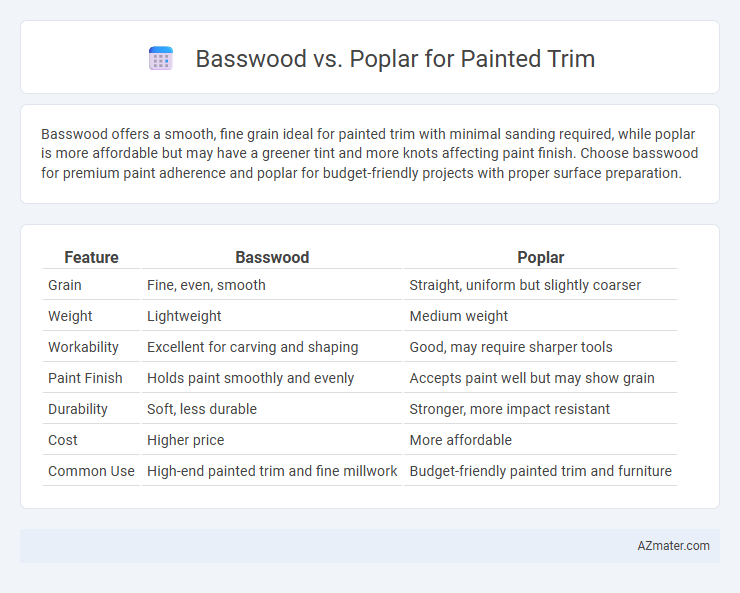Basswood offers a smooth, fine grain ideal for painted trim with minimal sanding required, while poplar is more affordable but may have a greener tint and more knots affecting paint finish. Choose basswood for premium paint adherence and poplar for budget-friendly projects with proper surface preparation.
Table of Comparison
| Feature | Basswood | Poplar |
|---|---|---|
| Grain | Fine, even, smooth | Straight, uniform but slightly coarser |
| Weight | Lightweight | Medium weight |
| Workability | Excellent for carving and shaping | Good, may require sharper tools |
| Paint Finish | Holds paint smoothly and evenly | Accepts paint well but may show grain |
| Durability | Soft, less durable | Stronger, more impact resistant |
| Cost | Higher price | More affordable |
| Common Use | High-end painted trim and fine millwork | Budget-friendly painted trim and furniture |
Introduction: Why Compare Basswood and Poplar for Painted Trim?
Basswood and Poplar are popular choices for painted trim due to their smooth grain and workability, key factors influencing finish quality and durability. Basswood offers a fine, uniform texture that enhances paint adhesion, while Poplar provides affordability and easy availability across regions. Comparing these woods helps in selecting the optimal material for trim that balances cost, appearance, and long-term performance in painted applications.
Basswood Overview: Characteristics and Properties
Basswood features a fine, even grain and a smooth texture, making it highly suitable for painted trim where a flawless finish is essential. Its lightweight yet stable nature resists warping and absorbs paint evenly, enhancing durability and aesthetic appeal. Poplar, while also commonly used, tends to have a coarser grain and can exhibit variations that may require more surface preparation for a perfect painted appearance.
Poplar Overview: Characteristics and Properties
Poplar is a lightweight hardwood known for its fine, even texture and uniform grain, making it an ideal choice for painted trim where smooth finishes are essential. Its pale yellow to light green coloration accepts paint exceptionally well, providing a consistent base without visible grain patterns. Poplar is also relatively stable with minimal warping or shrinking, ensuring durability and a clean, professional look in interior trim applications.
Workability: Cutting, Sanding, and Shaping
Basswood offers superior workability for painted trim due to its fine, even grain that cuts smoothly and sands effortlessly, reducing the risk of splintering or uneven edges. Poplar is also workable but tends to be slightly denser with occasional knots, requiring more careful sanding and shaping to achieve a flawless finish. Both woods accept paint well, but basswood's softness makes it easier to create detailed profiles and crisp trim lines.
Paint Adhesion and Finish Quality
Basswood offers superior paint adhesion and a smoother finish compared to poplar due to its fine, closed-grain texture that minimizes absorption and brush marks. Poplar, while affordable and easy to work with, often requires extra priming to achieve a uniform paint surface because of its more porous, open grain structure. Consequently, basswood is preferred for painted trim projects aiming for high-quality, durable finishes with minimal surface preparation.
Durability and Longevity for Interior Trim
Basswood offers superior durability and longevity for painted interior trim due to its dense, fine-grained texture that resists dents and warping over time. Poplar, while more affordable and easier to work with, tends to be softer and more prone to dents and scratches, which can affect the finish's lifespan. Choosing basswood ensures a more stable, long-lasting painted surface that maintains its appearance in high-traffic areas.
Cost Comparison: Basswood vs Poplar
Basswood generally costs more than poplar due to its finer grain and smoother texture, making it preferred for high-end painted trim projects. Poplar offers a more budget-friendly option while still providing good paint adhesion and uniform finish. Choosing between basswood and poplar depends on balancing cost constraints and desired quality for interior trim.
Availability and Sourcing
Basswood is widely available through specialty lumber suppliers and is prized for its fine grain and smooth surface, making it an excellent choice for painted trim. Poplar is more commonly found at major home improvement stores and offers greater availability at competitive prices, often favored for larger projects or budget-conscious sourcing. Both woods are sustainably harvested in North America, but poplar's stronger supply chain and regional growth make it easier to source in bulk.
Environmental Impact and Sustainability
Basswood and poplar both offer sustainable options for painted trim due to their fast growth rates and widespread availability, minimizing deforestation impacts. Basswood is often sourced from sustainably managed forests, with lower resin content reducing the need for chemical treatments, which benefits indoor air quality and environmental health. Poplar, while slightly less durable, is equally renewable and readily recyclable, making it a strong choice for eco-conscious homebuilders prioritizing low environmental footprint materials.
Verdict: Which Wood is Best for Painted Trim?
Basswood offers a smoother, more consistent grain that absorbs paint evenly, resulting in a flawless, durable finish ideal for detailed trim work. Poplar is more affordable and readily available but has a coarser texture that may require extra preparation to achieve a smooth painted surface. For the best quality and finish in painted trim, basswood is the preferred choice due to its superior paint adhesion and fine grain.

Infographic: Basswood vs Poplar for Painted Trim
 azmater.com
azmater.com